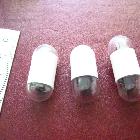Kapselendoskopie




















Capsule endoscopy is a non-invasive means of investigating the small bowel, principally for identifying the underlying cause of occult gastrointestinal tract bleeding, such as due to arteriovenous malformations, small bowel tumors, and ulcers. It is also used for the detection of the earliest manifestations of Crohn disease, such as mucosal ulceration, which are poorly detected by other imaging modalities such as small bowel MRI or ultrasound.
Where some doubt exists regarding the successful passage of a capsule endoscope, a patency capsule may be administered. This contains none of the electronics of a capsule endoscope, with barium included to render it radiopaque, and cellulose to enable degradation. Successful passage of a patency capsule implies that there is no stricture within the small bowel that would cause trapping of a capsule endoscope.
Radiographic features
Imaging may be requested if there is a delay in the passage of either a capsule endoscope or a patency capsule. A capsule endoscope is barrel shaped, with variable radiopaque internal circuitry and wall. A patency capsule will also be radiopaque but without any of the electronic components. Both of these types of devices are clearly identifiable on plain films and CT. MRI is contraindicated when these devices are known to be present within the small bowel.
Complications
Capsule endoscopes and patency capsules may be trapped within the small bowel proximal to strictures, or within diverticulae, often necessitating surgical removal.
Siehe auch:

 Assoziationen und Differentialdiagnosen zu Kapselendoskopie:
Assoziationen und Differentialdiagnosen zu Kapselendoskopie:
